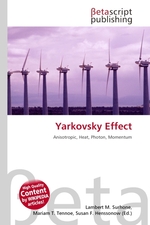Yarkovsky Effect
Lambert M. Surhone, Miriam T. Timpledon, Susan F. Marseken
бумажная книга
High Quality Content by WIKIPEDIA articles! The Yarkovsky effect is a force acting on a rotating body in space caused by the anisotropic emission of thermal photons, which carry momentum. It is usually considered in relation to meteoroids or small asteroids (about 10 cm to 10 km in diameter), as its influence is most significant for these bodies. The effect was discovered by the Russian civil engineer Ivan Osipovich Yarkovsky (1844–1902), who worked on scientific problems in his spare time. Writing in a pamphlet around the year 1900, Yarkovsky noted that the diurnal heating of a rotating object in space would cause it to experience a force that, while tiny, could lead to large long-term effects in the orbits of small bodies, especially meteoroids and small asteroids. Yarkovsky's remarkable insight would have been consigned to oblivion had it not been for the Estonian astronomer Ernst J. Opik (1893–1985), who read Yarkovsky's pamphlet sometime around 1909. Decades later, Opik, recalling the pamphlet from memory, discussed the possible importance of the Yarkovsky effect for moving meteoroids about the solar system.
Данное издание не является оригинальным. Книга печатается по технологии принт-он-деманд после получения заказа.


